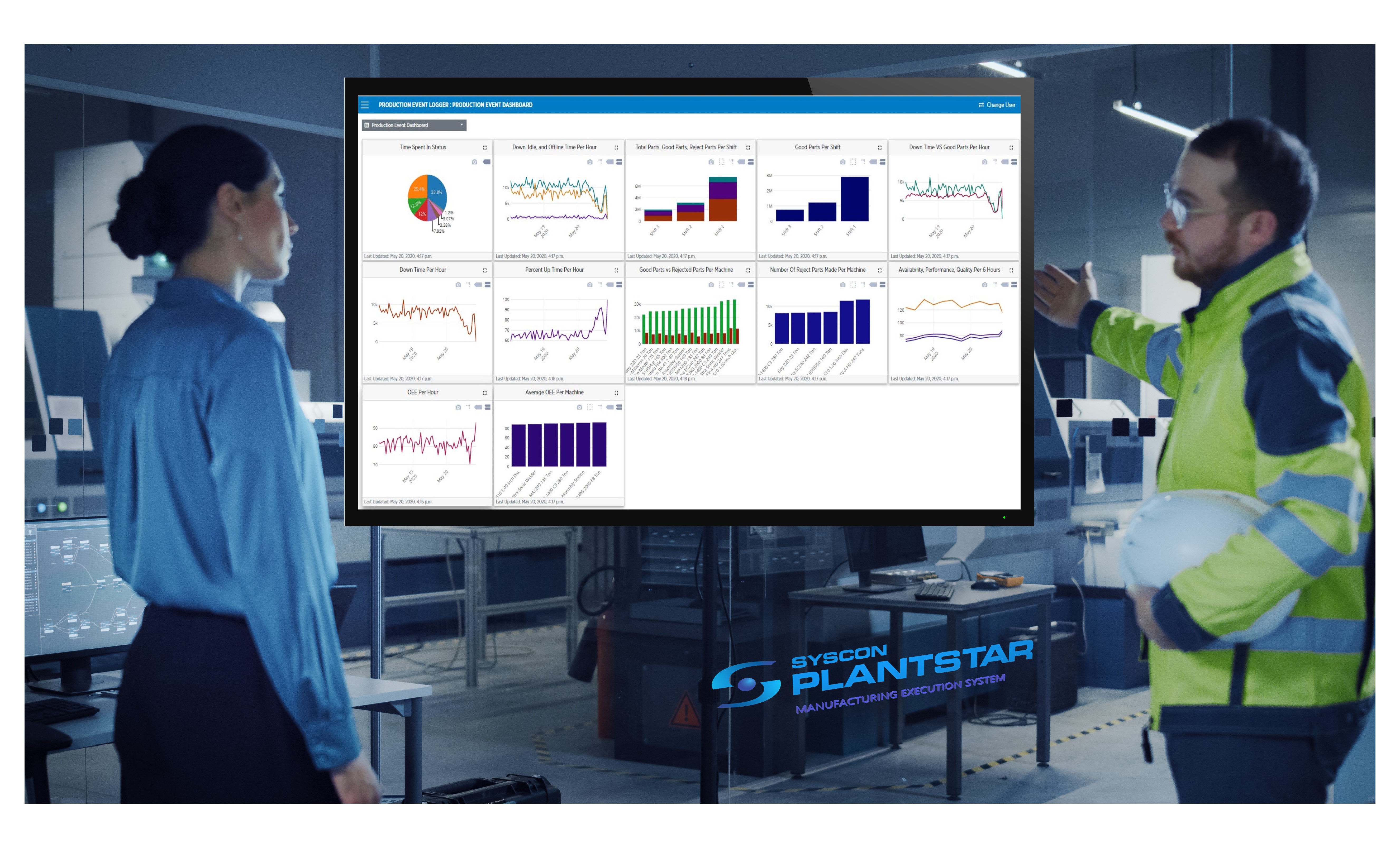SYSCON PlantStar BLOG
MES Dashboards Improve Manufacturing Operations
May 19, 2023 4:45:00 PM / by PlantStar Team

The internet of things (IoT) has dramatically changed how manufacturers oversee their operations. Numerous small devices can now generate information about manufacturing performance, such as the number of units produced as well as machines’ operating speeds and internal temperatures. Such data collection can be helpful, but large amounts of data can also be overwhelming. Manufacturing execution system (MES) dashboards provide data analysis and visualization that enables suppliers to separate actionable information from noise so they can identify bottlenecks, optimize processes, and increase revenue.
Below are some of the important benefits of MES dashboards.
Data Consolidation for Informed Decision-Making
With the IoT, suppliers can collect a lot of information about manufacturing runs, allowing them to see how well the supply chain is operating by examining items like barcode scanners, RFID tags, and gauge interfaces. They can examine overall equipment effectiveness (OEE) metrics like uptime, voltage usage, downtime, part counts, job completions, and cycle times as well as monitor distribution by tracking job completions and product delivery. After collecting all this information, however, manufacturers need a way to store, organize, and analyze it. MES software provides a solution, making it easy to glean actionable insights from manufacturing data.
An MES provides a central repository for manufacturing information and can also integrate with other enterprise systems like enterprise resource planning and product lifecycle management, providing a comprehensive view of the entire manufacturing process and supporting end-to-end traceability and compliance. Dashboards can be accessed via web browsers, mobile systems, machine interfaces, and a growing array of new and emerging user interfaces like voice commands. How the information is collected, analyzed, and displayed can be customized to meet the specific needs of each manufacturer.
From Reactive to Proactive Management
In the past, managers waited for reports to be run to determine what happened during production runs, missing opportunities to adjust as needed. With the growing power of technology like cloud-based computing, they can now examine information in real time. If a machine is laboring to complete its work, they can be alerted to the problem and take steps to alleviate it, greatly enhancing efficiency.
Reduce Reliance on Paperwork and Spreadsheets
Manufacturing is a well established industry, and many plants have been running for decades. Manufacturing processes were built on the technology that was available at the time: sticky notes once reminded employees what needed to be done, and many enterprises still work with cumbersome static spreadsheets. Relying on data entry, static spreadsheets are prone to human error, and because they do not update automatically, they’re almost instantly out of date.
Such problems have compounded as the volume of items tracked has grown and processes, such as material tracking, job scheduling, downtime tracking, job shift summary, and scrap reporting, have become more complex. An MES solution modernizes data collection by replacing traditional manual processes with modern digital exchanges. This real-time production monitoring allows legacy processes to be automated.
Increase Uptime
Nothing is more critical in the manufacturing industry than having machines up and running. An MES decreases downtime in a few ways. Real-time visibility into device performance lets companies see what equipment is operating well and what is having problems, providing the opportunity to take steps to mitigate any potential damage and prevent downtime. When needed, machines can be proactively taken offline for repairs or maintenance to keep the plant running smoothly.
Streamline Staffing
Like many sectors, the manufacturing industry has been experiencing significant staffing problems, especially since the pandemic. An MES provides managers an understanding of not only the current workflow and staffing needs but also future requirements. For example, if a needed material is expected to arrive ahead of its scheduled delivery date, decision-makers can consider the ramifications on areas like the factory floor and reallocate staff accordingly to maximize workforce productivity.
Boost Sales
As manufacturers use MES insights to make needed adjustments, improvements ripple throughout the organization. Company yields rise because batches are less likely to be tainted and face product recalls. The corporation prevents the loss of customers because of missed deadlines or poorly made products. First-time customers become repeat buyers when a company delivers products on time that perform as advertised. When customers have positive experiences, they refer coworkers and business associates, further increasing revenue.
MES dashboards are a manufacturing multiplier. They improve business outcomes by giving employees timely information that lets them do their jobs more effectively. Armed with actionable data, they make more informed decisions that strengthen the organization. These tools have become vital as manufacturing companies seek to optimize operations management.
Modern technology is capable of placing an overwhelming amount of information at manufacterers’ disposal. MES reports sift through this mountain of data, make correlations, and present the most important statistics with easily accessible and customizable dashboards. This visibility helps decision-makers better understand inventory management, machine performance, labor management, and workflow, helping them see where bottlenecks arise so they can take steps to reduce friction.
Topics: mes solutions
Subscribe to Email Updates
Posts by Topic
- Manufacturing Execution Systems (34)
- manufacturing solutions (16)
- MES 101 (12)
- Industry 4.0 (10)
- improve efficiency (9)
- mes software (9)
- mes solutions (9)
- Plastic Molding (8)
- Plastics Technology (8)
- Shop Floor Production (8)
- MES hardware (7)
- digital transformation (7)
- Reduce scrap (6)
- data-driven-decisions (6)
- lean manufacturing (6)
- process monitoring (5)
- product quality (5)
- Medical molding (4)
- lights-out manufacturing (4)
- manufacturing dashboard (4)
- production monitoring (4)
- Shop Floor Safety (3)
- supply chain management (3)
- ERP integration (2)
- Injection Molding Technology (2)
- defect collection (2)
- machine mes (2)
- process variables (2)
- digital strategy (1)
- labor gap (1)
- throughput (1)


